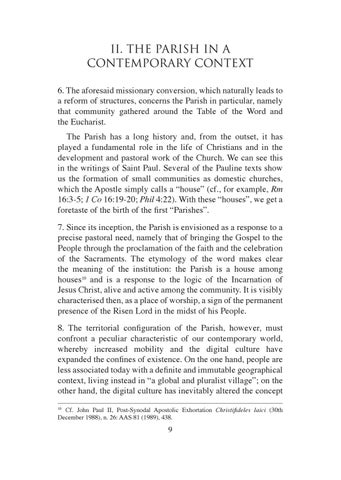II. THE PARISH IN A CONTEMPORARY CONTEXT 6. The aforesaid missionary conversion, which naturally leads to a reform of structures, concerns the Parish in particular, namely that community gathered around the Table of the Word and the Eucharist. The Parish has a long history and, from the outset, it has played a fundamental role in the life of Christians and in the development and pastoral work of the Church. We can see this in the writings of Saint Paul. Several of the Pauline texts show us the formation of small communities as domestic churches, which the Apostle simply calls a “house” (cf., for example, Rm 16:3-5; 1 Co 16:19-20; Phil 4:22). With these “houses”, we get a foretaste of the birth of the first “Parishes”. 7. Since its inception, the Parish is envisioned as a response to a precise pastoral need, namely that of bringing the Gospel to the People through the proclamation of the faith and the celebration of the Sacraments. The etymology of the word makes clear the meaning of the institution: the Parish is a house among houses10 and is a response to the logic of the Incarnation of Jesus Christ, alive and active among the community. It is visibly characterised then, as a place of worship, a sign of the permanent presence of the Risen Lord in the midst of his People. 8. The territorial configuration of the Parish, however, must confront a peculiar characteristic of our contemporary world, whereby increased mobility and the digital culture have expanded the confines of existence. On the one hand, people are less associated today with a definite and immutable geographical context, living instead in “a global and pluralist village”; on the other hand, the digital culture has inevitably altered the concept 10 Cf. John Paul II, Post-Synodal Apostolic Exhortation Christifideles laici (30th December 1988), n. 26: AAS 81 (1989), 438.
9

